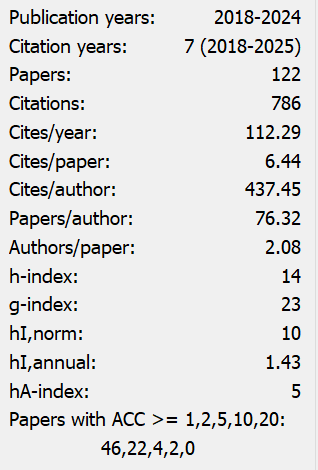The Impact of Human Resources Development on Small and Medium Enterprises (SMEs) Performance
The Case of Kosovo
Abstract
The purpose of this paper is to study the impact of the Human Resources Development (HRD) on the performance of small and medium enterprises (SMEs) in Kosovo. There is a large volume of research that support the positive relationship between HRD and the organizational performance. Most of such research was conducted in the developed countries and to a lesser extent in the developing countries (countries in transit). Through this study we confirmed the impact of the investments in various forms of HRD in the performance of the SMEs in Kosovo. This study provides empirical data that support the impact of training and development, career development and motivation of employees on organizational performance, but the results of this study do not support the impact of the education of entrepreneurs on the organizational performance.
References
Arend, R. J., & Lévesque, M. (2010). Is the Resource-Based View a Practical Organizational Theory? Organization Science, 21(4), 913-930. https://doi.org/10.1287/orsc.1090.0484
Armstrong, M. (2012). Armstrong’Handbook of Human Resource Menagement Practice. KoganPage, page, 274.
Armstrong, M., & Taylor S. (2014). Armstrong’s handbook of human resource management practice 13th edition, page 7.
Arthur, W., Benett, W., Edens, P. S., & Bell, S. T. (2003). Effectiveness of Training in Organizations: A Meta-Analysis of Design and Evaluation Features. Journal of Applied Psychology, Journal of Applied Psychology, 88(2), 234-245. http://doi.org/10.1037/0021-9010.88.2.234
Bao, C., & Nizam, I. (2015). The impact of motivation on employee performance in the electronics industry in CHINA. International Journal of Accounting & Business Management, 3(2), 29-45.
Barron, J. M., Berger, M. C., & Black, D. A. (1999). Do Workers Pay for On-The-Job Training? The Journal of Human Resources, 34(2), 235-252. http://doi.org/10.2307/146344
Becker, B. (1962) Investment in Human Capital: A Theoretical Analysis. Journal of Political Economy, 70(5), Part 2: 9-49. http://dx.doi.org/10.1086/258724
Bowen, D. E., & Ostroff, C. (2004): Understanding HRM-Firm Performance Linkages: The Role of the "Strength" of the HRM System. Academy of Management Review, 29(2), 203-221. http://doi.org/10.2307/20159029
Boxall, P. F. (1996). The strategic HRM debate and the resource-based view of the firm. Human Resource Management Journal, 6(3), 59-75.
BSC Kosovo. (2013). Entrepreneurship and Small Business Development in Kosovo in 2012. RESEARCH REPORT
Budd, M. L., & Hannum, W. H. (2016). A New Vision for HRD to Improve Organizational Results: Educational Technology, 56(4), 21-25.
Çalişkan, E., N. (2010). The Impact of Strategic Human Resource Management on organizational performance. Journal of Naval Science and Engineering, 6(2), 100-116.
Chisholm, A. M., & Nielsen, K. (2009). Social Capital and the Resource-Based View of the Firm. International Studies of Management & Organization, 39(2), 7-32. https://doi.org/10.2753/IMO0020-8825390201
DeCenzo, A. D., Robbins, P. S., & Verhults, S. L. (2010). Fundamentals of Human Resource Management 10th edition-Wiley page, 7.
Delaney, J. T., & Huselid, M. A. (1996). The Impact of Human Resource Management Practices on Perceptions of Organizational Performance. Academy of Management Journal, 39(4), 949-969. https://doi.org/10.2307/256718
Dencker, J.C., Gruber, M., & Shah, S. K. (2009). Pre-entry knowledge, learning, and the survival of new firms. Organization Science, 20(3), 516-537. https://doi.org/10.1287/orsc.1080.0387
Dialoke, I., & Nkechi, P. A. J. (2017). Effects of career growth on employees performance: A study of non-academic staff of michael okpara university of agriculture umudike abia state, Nigeria. Singaporean. Journal of Business economics, and management StudieS (SJBEM), 5(7), 8-18.
Echdar, H. S. (2013). Effect of Internal and External Environment of Human Capital Development (Empirical Study on Manufacturing Company Gopublik in Indonesia), Journal of Business and Management, 11(3), 39-56.
Gagnon, M. E., & Smith, M. (2013). The Effects of a Training Levy on Training Characteristics and Outcomes: The Case of Quebec. Relations Industrielles / Industrial Relations, 68(1), 120-141.
Gamage, A. (2007). Impact of HRD Practices on Business Performance: An empirical analysis of manufacturing SMEsin Japan. pp. 85-109. Retrieved from https://learning.uonbi.ac.ke/courses/DHR503/document/impact_of_HRD_on_organisational_performance_case.pdf
Garavan, Th. N. (2007). A strategic perspective on human resource development. Advances in Developing HumanResurces, 9(1), 11-30. https://doi.org/10.1177/1523422306294492
Grossman. R., & Salas, E. (2011). The transfer of training: Wat really matters. Internacional Journal of Training and Development, 15(2), 103-120. https://doi.org/10.1111/j.1468-2419.2011.00373.x
Hameed, A., & Waheed, A. (2011). Employee Development and Its Affect on Employee Performance A Conceptual Framework. International Journal of Business and Social Science, 2(1), 224-229.
Hatch, N. W., & Dyer, J. H. (2004). Human Capital and Learning as a Source of Sustainable competitive Advantage. Strategic Management Journal, 25(12), 1155-1178. https://doi.org/10.1002/smj.421
Hyz, A. B. (2011). Small and Medium Enterprises (SMEs) in Greece - Barriers in Access to Banking Services. An Empirical Investigation, International Journal of Business and Social Science, 2(2), 161-165.
Institute for Development Research, Riinvest (2017). The business climate in Kosovo from the perspective of SMEs (Albanian).
Kalleberg, A. L., & Moody, J., W. (1994). Human Resource Management and Organizational Performance. American Behavioral Scientist, 37(7), 948-962. https://doi.org/10.1177/0002764294037007007
Karadag, H. (2016). The Role of SMEs and Entrepreneurship on Economic Growth in Emerging Economies within the Post-Crisis Era: An Analysis from Turkey. Journal of Small Business and Entrepreneurship Development, 4(1), 22-31. https://doi.org/10.15640/jsbed.v4n1a3
Katou, A. A. (2008). The Impact of Human Resource Development on Organisational Performance: Test of a Causal Model. Journal of Behavioral and Applied Management. Retrieved from https://www.researchgate.net/publication/242091942
KBRA (Kosovo Business Registration Agency, 2017). Report of Basic Performance Indicators for Business Registration in Kosovo for the Period: July-December 2016 (Albanian).
Keith, N., & Frese, M. (2008). Effectiveness of error management training: A meta-analysis. Journal of Applied Psychology, 93(1), 59-69. https://doi.org/10.1037/0021-9010.93.1.59
Kraiger, K., McLinden, D., & Casper, W. J. (2004). Collaborative Planning for Training Impact. Human Resource Management, 43(4), 337-351. https://doi.org/10.1002/hrm.20028
Kraja, G. (2015). Training, development and Performance (Case study of the Albanian Public Administration). Journal of Sociological Research, 6(1), 129-140. https://doi.org/10.5296/ jsr.v6i1.7905
Krasniqi, B. (2007). Barriers to entrepreneurship and SME growth in transition: the case of Kosova. Journal of Developmental Entrepreneurship, 12(1), 71-94. https://doi.org/10.1142/S1084946707000563
Kumar, Ch. Sh. (2006). Human Capital and Growth Empirics. The Journal of Developing Areas, 40(1), 153-179. https://doi.org/10.1353/jda.2007.0006
Kumari, P., & Mishra, R. (2009). Implementing Human Resource Development as a tool for Effective Organization Change. SSRN (ssrn.com/abstract=1437844) https://doi.org/10.2139/ssrn.1437844
Lado, A. A., & Wilson, M. C. (1994). Human resource systems and sustained competitive advantage: a competency based perspective. Academy of Management Review, 19(4), 699-727.
Lechthaler, W. (2011). Firm Training and Capital Taxation. Journal of Institutional and Theoretical Economics. Zeitschrift für diegesamte Staatswissenschaft, 167(2), 175-201.
Mabey, Ch. ( 2008). Management Development and Firm Performance in Germany, Norway, Spain and the UK. Journal of International Business Studies, 39(8), 1327-1342. https://doi.org/10.1057/palgrave.jibs.8400405
Mahoney, J. T., & Pandian, J. R. (1992). The resource-based view within the conversation of strategic management. Strategic Management Journal, 13(5), 363-380. https://doi.org/10.1002/smj.4250130505
Mark, L., & Nzulwa, J. (2018). Effect of career development programs on employee performance in kenya. a case of national hospital insurance fund. International Journal of Social Sciences and Information Technology, IV(V), 693-709.
Martin, B. C., McNally, J. J., & Kay, M. J. (2013). Examining the formation of human capital in entrepreneurship: A meta-analysis of entrepreneurship education outcomes. Journal of Firm Venturing, 28(2), 211-224. https://doi.org/10.1016/j.jbusvent.2012.03.002
Mittal Sh. (2013). HRD Climate in Public & Private Sector Banks. Indian Journal of Industrial Relations, 49(1), 123-131.
Mohamad, M. H., & Yahya, K. K. (2017). Perceived career development practice and performance of employees: an empirical study in the enforcement organization. Journal of Global Business and Social Entrepreneurship (GBSE), 1(4), 54-61.
Morris, M. A., & Robie, Ch. (2001). A meta-analysis of the effects of cross-cultural training on expatriate performance and adjustment. International journal of training & Development, 5(2), 112-125. https://doi.org/10.1111/1468-2419.00126
Noe, R., A. (1996). Is Career Management Related to Employee Development and Performance? Journal of Organizational Behavior, 17(2), 119-133.
Oginni, B. O., & Adesanya, A. S. (2013). Business Environmental Factors: Implications on the Survival andGrowth of Business Organisations in the Manufacturing Sector of Lagos Metropolis. Business and Management Research, 2(3), 146-155 http://dx.doi.org/10.5430/bmr.v2n3p146
Okoye P.V.C &. Ezejiofor, R., A. (2013). The- Effect of Human Resources Development on Organizational Productivity. International Journal of Academic Research in Business and Social Sciences, 3(10), 250-268 https://doi.org/10.6007/IJARBSS/v3-i10/295
Onanda, B. (2015). The effects of Motivation on Job performance, A case study of KCB Coast Region. nternational Journal of Scientific and Research Publications, Volume 5, Issue 9, pp. 1-13
Powell, K. S., & Yalcin, S. (2010). Managerial training effectiveness: A meta‐analysis 1952‐2002. Personnel Review, 39(2), 227-241. https://doi.org/10.1108/00483481011017435
Said, N. Sh. M., Zaidee, A., Zahari, A. S. M., Ali, S., & Salleh, S. M. (2015). Relationship between Employee Motivation and Job Performance: A Study at Universiti Teknologi MARA (Terengganu). Mediterranean Journal of Social Sciences, 6(4), 632-638 https://doi.org/10.5901/mjss.2015.v6n4s2p632
Salas, E., Tannenbaum, S. I., Kraiger, K., & Smith-Jentsch, K. A. (2012). The Science of Training and Development in Organizations: What Matters in Practice. Psychological Science in the Public Interest, 13(2), 74-101. https://doi.org/10.1177/1529100612436661
Sandamali, J. G. M., Padmasiri, M. K. D. Mahalekamge, W. G. S., & Mendis, M. V. S. (2018). The Relationship between Training and Development and Employee Performance of Executive Level Employees in Apparel Organizations. International Invention of Scientific Journal, 2(1), 12-17
Schultz, Th. W. (1961). Investment in Human Capital. The American Economic Association, 51(1), 1-17.
Shoraj, D., & Llaci, Sh. (2015). Motivation and Its Impact on Organizational Effectiveness in Albanian Businesses. SAGE Open, pp. 1-8. https://doi.org/10.1177/2158244015582229
Suyanto, Sapta, I. K. S., & Sudja, I. N. (2018). The Effect of Career Development and Leadership on Employee Performance with Work Motivation as Intervening Variables on Cv. Blue Waters Bali. International Journal of Contemporary Research and Review, 9(3), 20583-20591 https://doi.org/10.15520/ijcrr/2018/9/03/467
Swanson, R. A. (1995). Human resource development: Performance is the key. Human Resource Development Quartely, 6(2), 207-213
TAK. (Tax Administration of Kosovo) (2018). Management Reports (Albanian).
Toft-Kehler, R., Wennberg, K., & Kim, P. H. (2014). Practice makes perfect:Entrepreneurial-experience curves and venture performance. Journal of Business Venturing, 29(4), 453-470. https://doi.org/10.1016/j.jbusvent.2013.07.001
Torraco, R. J. (2005). Work Design Theory: A Review and Critique with Implications for Human Resource Development. Human Resource Development Quarterly, 16(1), 85-109. https://doi.org/10.1002/hrdq.1125
Torraco, R. J., & Swanson, R. A. (1995). The strategia roles of human resource development. Humane Resource Planning, 18(4), 10-21.
Wright, P. M., Gardner, T. M., & Moynihan, L. M. (2003). The impact of HR practices on the performance of business units.Human Resource. Management Journal, 13(3), 21-36.


This work is licensed under a Creative Commons Attribution 4.0 International License.
Copyright for this article is retained by the author(s), with first publication rights granted to the journal.
This is an open-access article distributed under the terms and conditions of the Creative Commons Attribution license (http://creativecommons.org/licenses/by/4.0/).


























